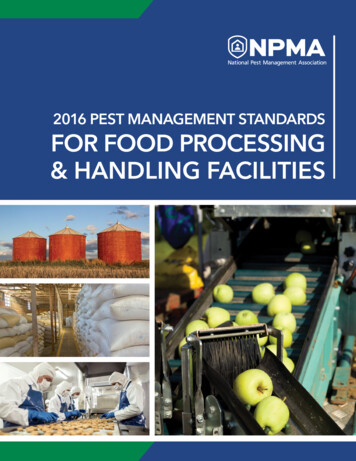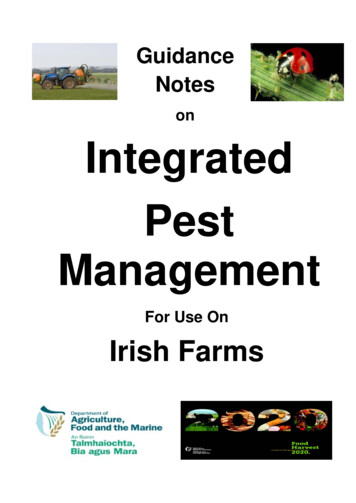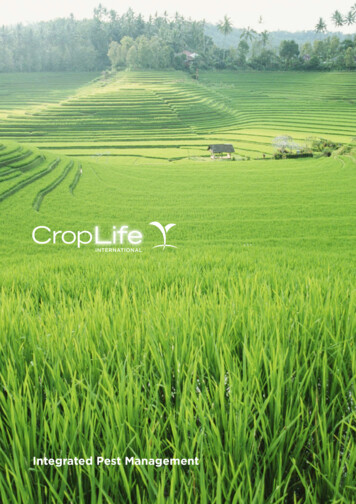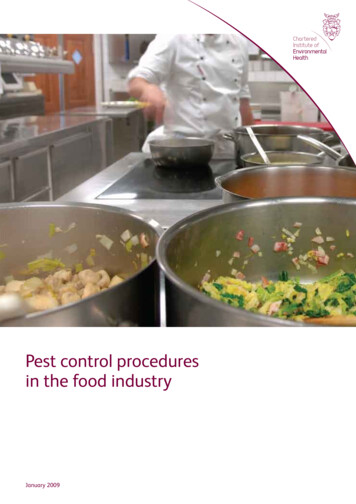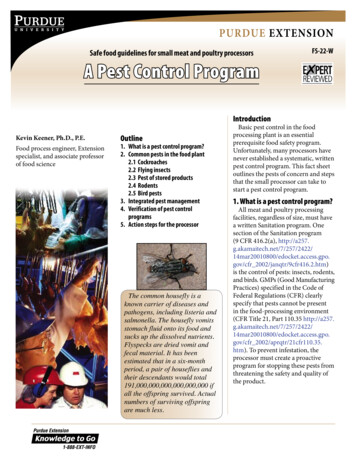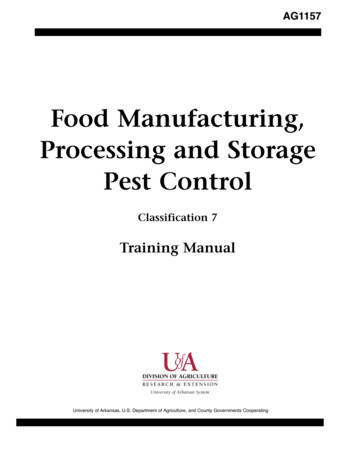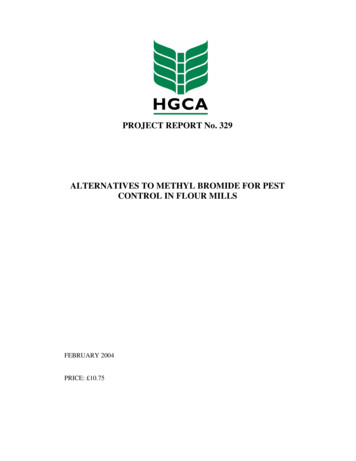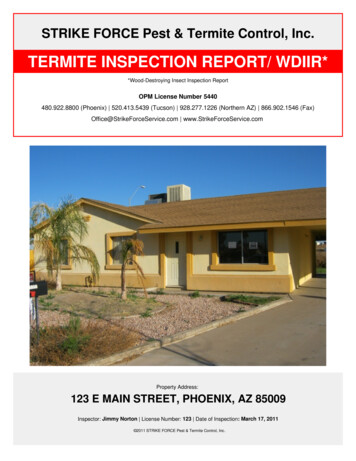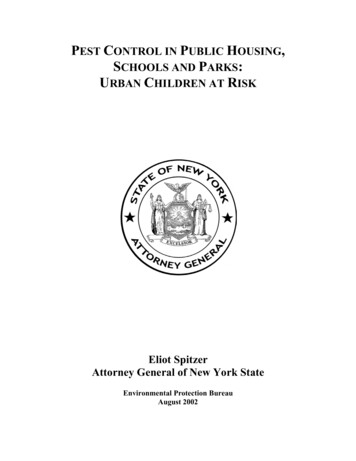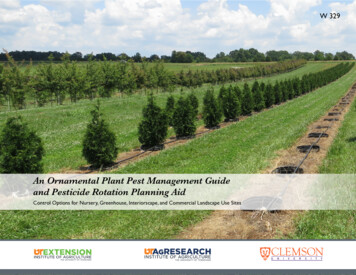
Transcription
W 329An Ornamental Plant Pest Management Guideand Pesticide Rotation Planning AidControl Options for Nursery, Greenhouse, Interiorscape, and Commercial Landscape Use Sites
An Ornamental Plant Pest Management Guide and Pesticide RotationPlanning AidControl Options for Nursery, Greenhouse, Interiorscape, and Commercial Landscape Use SitesJuang-Horng “JC” ChongAssociate ProfessorDepartment of Agricultural and Environmental SciencesClemson UniversityWilliam E. KlingemanProfessorDepartment of Plant SciencesUniversity of Tennessee Institute of AgricultureFrank HaleProfessorDepartment of Entomology and Plant PathologyUT ExtensionUniversity of Tennessee Institute of AgricultureFor additional information, contact your county Extension office, or:Clemson UniversityPee Dee Research and Education Center2200 Pocket RoadFlorence, SC 29506-9727www.clemson.eduUT Institute of AgricultureUT Extension2621 Morgan Circle121 Morgan HallKnoxville, TN 37996extension.tennessee.edu
Special Notes Regarding Use of This Publication: Pest resistance to insecticides and acaricides is a growing concern. Efforts to limit pesticide resistance should be an active part of IPMdecision-making. Populations of pest species infesting ornamental plants—like Tetranychus and Panonychus spider mites, western flowerthrips, glasshouse and silverleaf whiteflies, and green peach aphids—are among the top 12 species to have developed resistance tomultiple pesticide active ingredients (a.i.) spanning several chemical classes. Cross-resistance by populations of pest arthropods isincreasingly common to multiple a.i. products within an IRAC group. Serial applications to control a generational cycle of a pest shouldNOT be made using a.i. products within an IRAC Group. Cross-resistance occurs much less commonly between IRAC groups. Seefootnote 25 for information about recommendations for rotation between IRAC groups, particularly when managing select pest populations. More detailed information about modes of action and pesticide resistance will be forthcoming in a publication titled “UnderstandingInsecticide and Miticide Modes of Action Used to Manage Arthropod Pests of Ornamental Plants.” Product labels change frequently and will include more details and specifics about potential phytotoxity that may result in certain plantspecies when products are applied or used at certain rates. All product labels should be reviewed prior to treatment application. Footnote 12as provided within the chart can assist in indicating products with labels that may provide additional details regarding plant safety. Many product labels, particularly among generic products (e.g., carbaryl, bifenthrin, imidacloprid and others) differ in many regards,including which pests may be controlled, details about plant safety/phytotoxicity, re-entry intervals, etc. It is the applicator’s responsibilityto consult each product label prior to application and understand its restrictions and limitations.University of Tennessee Disclaimer NoticeThis publication contains pesticide recommendations that are subject to change at any time. The recommendations in this publication are provided only as a guide. It is always thepesticide applicator's responsibility, by law, to read and follow all current label directions for the specific pesticide being used. The label always takes precedence over therecommendations found in this publication. Use of trade or brand names in this publication is for clarity and information; it does not imply approval of the product to the exclusionof others that may be of similar, suitable composition, nor does it guarantee or warrant the standard of the product. The author(s), the University of Tennessee Institute ofAgriculture and University of Tennessee Extension assume no liability resulting from the use of these recommendations.Clemson University Precautionary StatementIn order to protect people and the environment, pesticides should be used safely. This is everyone’s responsibility, especially the user. Read and follow label directions carefullybefore you buy, mix, apply, store or dispose of a pesticide. It is a violation of State and Federal Laws to use pesticides in a manner inconsistent with its label.Clemson University Disclaimer StatementPesticides recommended in this publication were registered for the prescribed uses when printed. Pesticide registrations are continuously being reviewed. Should registration of arecommended pesticide be canceled, Clemson University would no longer recommend it. This information is supplied with the understanding that no discrimination is intendedand no endorsement by the Clemson University Cooperative Extension Service is implied. Brand names of pesticides are given as a convenience and are neither an endorsementnor guarantee of the product nor a suggestion that similar products are not effective. Use pesticides only according to the directions on the label. Follow all directions, precautionsand restrictions that are listed.
1An Ornamental Plant Pest Management Guide and Pesticide Rotation Planning AidLace bugsFlea beetlesLeaf beetles and otherLeaf-feeding beetlesJapanese beetles (adult)White grubs (incl. Japanese& Oriental beetle larvae)WeevilsCaterpillarsSawfliesGall-forming pestsLeafminer (fly & midge)Leafminer (moth)Leafminer (wasp)xxlhxxxxxt/s*2xxxxp, w, m,fxxxmethiocarbMesurol 75WN, G24x25L, N, G24xxxxxxxlhxxxxLepitect13L, N, G24xxxxlhx12xxxxxxxxG, NxxxxPrecise hion 8F12N12Supracide 2E12,23N3 daysDimethoate 4E ,124EC12,13Malathion 5ECHarpoon14,23Dylox 420 SLL0xxN10daysxxLN/Axxxxlhxxxlhxxlhxxxxxxxxxxxxxp, w, m,fxxxfxp, wxxxxpxxxxxxxxxxxxxxxt/s*224Attain TRG12xxxxxxMenace GCL, N, G12xxxxxxxlhxxxxxOnyxLN/AxxxxxxxxlhxxxxL, N, I12xxxxxxxxlhxxxN, gxxxfgxxxfgxx12xxxxxxxlhxxxxxxxxxfgxL, IN/AxxxxxxxlhxxxxxxxxxxfgxTempo SC Ultra18Scimitar CS;Scimitar GCDemon WPL, IN/AxxxxxxxlhxxxxxxxxxxfgxL;L, N, GL, I24;24N/Axxxxxxxlhxxxxxxxx18L, IN/Axxxx12N, G, I24xxxxxxxTame 2.4 ECtau-fluvalinateMavrik AquaflowL, N, G, I12permethrinAstroL, G, I12pyrethrinspyrethrumbifenthrin clothianidinbifenthrin imidaclopridcyfluthrin imidaclopridlambdacyhalothrin thiamethoxampyrethrins piperonyl11butoxidexxL, N, G, IDeltaGard GxxDecathlondeltamethrinxxTempo Ultra xxxL10xxL, rinPyrethroids Piperonyl butoxide(PBO)xxTalstar Nursery G3A 27AxN/ATalstar S Select10Pyrethroids NeonicotinoidsxL12OnyxPro3A 4AxInject-A-Cide B1410Sodium channelmodulatorsxxTopChoice3A 25x24CeaseFire16fipronilxx2415,23GABA-gated chloridechannel antagonistsxNN, GConcentrate2BxDursban 50W12xxxxxDuraGuard ME12MSR SpraytrichlorfonAdelgids6212Orthene T&OxSpider mitesPlant bugsxEriophyid mitesLeafhoppers &/or7planthoppersxBroad miteThripsx10WhitefliesxFire antMealybugsxMidges & fliesSoft scalesxFungus gnat and/or9Shore fliesArmored scales12Longhorned (roundheaded)borersPsyllidsL, N, GBark and pine beetlesAphidsSevin SLAmbrosia beetlesREI (hours)carbaryl11Flatheaded borersUse SiteAcetylcholinesteraseinhibitorsClearwing borersSelected Trade Names1BMode of Action3IRAC Code1A8Active IngredientCarbamates4,5Chemical subgroupControl Options for Nursery, Greenhouse, Interiorscape and Commercial Landscape Use Sites2Juang-Horng ‘JC’ Chong, William E. Klingeman, and Frank xxxxxxxxxfgxfgxL, usN, G12xxxxxxxxxxxPyganicN, G12Pyrethrum TRN, G12Aloft LC G, LC SCLN/AAllectus SCL, IN/Axxxxlh, phxxxxxxxxxxxxxxxxxxxxxxxxxxL, N, G, IxxxxPerm-Up 3.2 ECxxxxxxxPermethrin lhxxxDiscus N/GN, G, I12xxxxxxxxxTandemLN/AxxxxxxxxxlhxPyreth-ItN, xxxxxfg, sfxxxxxxxxxxxxxfgxfgxxxxxxxxxx
clothianidindinotefuranNicotinic acetylcholinereceptor allostericactivators56 25Chloride channelactivatorsSulfoxaflor Spinosynssulfoxaflor abamectin12milbemectinabamectin bifenazate6 unJuvenile hormoneJuvenile hormone Axxxxxxxx19xlhxxxx19xxlh ,phxL, N, G, I12xxxx19xxxMarathon II13N, G, I12xxxx19xxxMarathon 60WP13N, G, I12xxxx19xxxxxlhMerit13L, xxfgL, xxxxxxFlagship 25WG13N, G, I12xxxxxxxxlhxxxxxxxxMeridian 0.33G13L, IN/AxxxxxxxlhxxxxxxxxxxlhxxxxxxL, IN/AL, N, G12Conserve SCL, N, G4EntrustL, N, G4Lucid, Avid12L, N, G1214L, N, G, IN/AAward II16L, 18L, N, G, I12G, I44G12L, N, G, I126xxxxxxxxxxxxxxxxxxxxxxxxxxxfgSpider mitesEriophyid mitesBroad mite10Fire antxxxxp, w, xlhxxxxxxxxxxxxxfgxxxxxxfg,sfxxfg,sfxL, N12L, N, G, ahydratePrev-AM UltraN, GPymetrozinepymetrozineEndeavor12,18L, N, G, I12xFlonicamidflonicamidAria12,20L, N, G12xClofentezineclofentazineOvation SC12N, G12HexythiazoxhexythiazoxL, N, G, I12EtoxazoleetoxazoleHexygon DF12,18Beethoven TRG24TetraSan 5 WDGL, N, G, I12XenTariL, N, G, I4GrubGONE! GN, G, L, I4Gnatrol WDGN, G, I4Dipel Pro DFL, N, G, I4L, N, G4812xxp, w, fxFulcrum50WPxxDistanceMeraz, ProMitexx19xxN, G, I13xxx1320xfgt/s*xxx23xXXpireMidges & fliesxFungus gnat and/or9Shore fliesLonghorned (roundheaded)borersBark and pine beetlesAmbrosia beetlesFlatheaded borersxClearwing borersxLeafminer (wasp)Leafminer (moth)xLeafminer (fly & midge)8xGall-forming pestsSawfliesPlant bugsCaterpillarsLeafhoppers &/or7planthoppersxlh13WeevilsThripsx19x19Xytect 75WSP; 2FWhite grubs (incl. Japanese& Oriental beetle larvae)WhitefliesJapanese beetles (adult)MealybugsLeaf beetles and otherLeaf-feeding beetlesSoft scalesxxL, NOrganotin miticides fenbutatin-oxideFlea beetlesArmored scalesxxEnstar AQ11Lace bugsPsyllidsxxs-kinoprenekurstakiInhibitors ofmitochondrial Microbial disruptors of thuringiensis (Bt )Bt subsp. aizawai& insecticidalinsectmidgut membranesproteinsBt subsp.galleriaeBt subsp.israelensisBt subsp.xxDistance IGR1210Bxxxxxxpyriproxifen25xxPyriproxyfenMite growth inhibitorsxlh127C10A 25x12fenoxycarb9CxL, N, G, IFenoxycarb9B 25xSafari 20 SG137BMiscellaneous nonspecific (multi-site)inhibitorsSelective homopteranfeeding blockersx12ExtinguishPreclude TR8DxL, IAracinate TMemamectinbenzoatexL, N, G, IMeridian 25WG25xSafari 2G13CoreTect134C 5xArena 50 WDG13Discus Tabletsthiamethoxam1212Transtect 70 WSP1311L, N, G213L, IArena 0.25 GZylam LiquidimidaclopridAdelgidsTriStar 8.5 SL12.13,186acetamipridREI (hours)Selected Trade NamesNeonicotinoidsUse SiteActive Ingredient4,5Chemical subgroupMode of Action3IRAC CodeNicotinic acetylcholinereceptor agonists4A 25xxxxlhxxxxxxxxxfgxx
Inhibitors of chitinbiosynthesis, type 1Moulting disruptor,DipteranEcdysone receptoragonists16171820AMitochondrial complexIII electron transportinhibitors20B 2522AVoltage-dependentsodium channel blockers22BInhibitors of acetyl CoAcarboxylase23Mitochondrial complex IIelectron transportinhibitorsRyanodine 12N, G12L, N, G12CyromazinecyromazineCitationL, N, G, I12DiacylhydrazinesmethoxyfenozideIntrepid 2FL, N, G, I4xtebufenozideConfirm 2F21N4xHydramethylnonhydramethylnonAmdro Pro16L, N12AcequinocylacequinocylShuttle 15 SCMETI acaricidesand insecticidesL, I12N, G12fenazaquinMagus12L, N, G, I12fenpyroximateAkari 5SCN, G, I12pyridabenSanmiteN, Siesta16L, N12Tetronic andTetramic acidderivativesspiromesifenForbid 4F12Broad miteEriophyid mitesSpider mites10Fire antMidges & fliesFungus gnat and/or9Shore fliesLonghorned (roundheaded)borersBark and pine beetlesAmbrosia beetlesFlatheaded borersClearwing borersLeafminer (wasp)Leafminer (moth)Leafminer (fly & DiamideschlorantraniliproleAceleprynL, IN/AcyantraniliproleAcelepryn GMainspringL, IG, IN/A4azadirachtin11Azatin OL, N, G, I4PyrifluquinazonxxxxL, N, G, lite ivesDicofolx19xlh, phx1224CryolitexxN/AN, G, IbifenazatexLKontos12Bifenazatexxfg,sfxxxxN, GspirotetramatAzadirachtinxGall-forming pests8xxxTalus 70DFxSawfliesCaterpillarsWeevilsWhite grubs (incl. Japanese& Oriental beetle larvae)Japanese beetles (adult)Leaf beetles and otherLeaf-feeding beetlesFlea beetlesLace bugsPlant bugsLeafhoppers rofezin12Mitochondrial complex Ielectron es1212Mealybugs12Soft scalesGL, NL, N2Adept12Dimilin 25WDimilin 4LArmored ibitors of chitinbiosynthesis, type 0GAdelgidsPylon126chlorfenapyrREI (hours)ChlorfenapyrUse SiteSelected Trade Names4,5Active Ingredient25Chemical subgroup15Uncouplers of oxidativephosphorylation viadisruption of the protongradientMode of Action3IRAC Code13xxxxx22xxxxxAzatrol EC InsecticideL, N, G, I4xxxMolt-XL, N, G, I4Ornazin 3% ECL, N, G, I12xxxxxxTreeAzin14L, N, GuntildryFloramite SCL, N, G, I12Floramite xlhxx22xxxx4L, N, Gxx22xN, G, IKryocide5xxAzatin XLKelthane23Overture 35 xxxxxxxxxxxxxxxxxlhxx
Isariaformosorosea( Paecilomycesfumosoroseus )MetarhiziumanisopliaeSteinernema nemakraussei11,12xxxL, N, G4xxxxLN/AxxxxxxB-Green, TerraNemAdelgids62Grandevo PTOLarvaNemLN/AExhibitline HNN/ANemasys GTerranem-NAmNemaShield HBL, N, G, IL, N, G, IL, N, G, IN/AN/AN/ANoFlyG12xxxxxxxxxxPreferalL, N, G4Met52, Tick-EXL, N, G4L, N, G, IN/AL, N, G, IN/ANematac CL, N, G, IN/AExhibitline SCCarpocapsae-SystemL, N, G, IL, N, G, IN/AN/ACapsanemL, N, G, IN/ANemaSys,Steinernema-SystemL, N, ,G, IN/AxNemaShieldL, N, G, IN/AxEntoNemL, N, G, IN/AxNemasys LL, N, G, xfgxfgxfgxxxNN/AL, N, G, I4xxxxxxxxL, N, G, I12xxxxxxxxxx19xlh,19Surround WPL, N, G, IN/Aneem oil11TrilogyL, N4xxxxx19xL, N, G, I4xxxxx12xxkaolin clayTriact 70xlhxxxTigraNemM-PedexxxMillenium12xSpider mitesxEriophyid mitesxBroad mite410L, N, G13Fire antxMidges & fliesxNaturalis-L26xlh,phxFungus gnat and/or9Shore fliesxLonghorned (roundheaded)borersxBark and pine beetlesxAmbrosia beetlesxFlatheaded borersxxClearwing borersx4Leafminer (wasp)xL, N, G, ILeafminer (moth)xBotaniGard 22 WPLeafminer (fly & midge)Leaf beetles and otherLeaf-feeding beetlesxlh,ph8Flea beetlesxGall-forming pestsLace bugsxSawfliesPlant bugsxCaterpillarsLeafhoppers &/or7planthoppersWeevilsThripsWhite grubs (incl. Japanese& Oriental beetle larvae)WhitefliesJapanese beetles (adult)MealybugsxSoft scalesxArmored scalesPsyllidsx4Kraussei-Systemsoapt/s*2L, N, G, Ihorticultural oil11,12 Ultra-Pure Oil, eterorhabditisbacteriopheraxxREI (hours)11xBotaniGard ESSelected Trade NamesActive IngredientBeauveriabassianaUse Site4,5VariousChemical subgroupMode of Action3IRAC xxxlhxxx19xxxx19xxmxlhxxxx19x19sfxx19last updated May 2015
Explanations and Supplemental Notes1. Pests listed on pesticide labels are subject to change. Pests listed on pesticide labels are subject to change. Within states and counties, products may have additional permitted uses by 2(ee) and Special Local Need allowances.Consult your County Extension Agent or State Agency to determine if other uses are allowable. The label should always be consulted to confirm that chart-listed pests still appear on the label. Check the product labels for specificsite restriction information, notes on application, sensitive plant species and specific target pest species.2. Use site information is provided for reference only: L landscape; N nursery; G greenhouse; I interiorscape. t/s* Products listed for use in L, N, G or I sites may include active ingredients in differently labeled products that aredesignated for use in turfgrass or sod production use sites. Mention of those products is beyond the scope of this resource guide, and products listed herein may not be legal or appropriate for site uses in turfgrass or sodproduction.3. IRAC Code designations and Related Modes of Action are explained at the Insecticide Resistance Action Committee Database 2014 (IRAC 2013; 4. Trade names of products are provided as examples only. No endorsement of mentioned product nor criticism of unmentioned products is intended.5. Products may not be registered or renewed for use in all southeastern U.S. states. Consult your state's Department of Agriculture to confirm legal use of products in your state.6. Re-Entry Interval (REI) designations apply to agricultural (nursery) uses. Within the Re-Entry Interval (REI) designation, 'N/A' is used to indicate products with Landscape and/or Interiorscape site uses and that present Non-AgriculturalUse Requirements. Additionally, some product labels may list site uses that are beyond the scope of this publication (e.g., sod farms, pastures, rights-of-way, etc.). These site uses may involve Agricultural Use Requirements thatlist an REI not presented here. Consult the product labels for specific details required for compliance within those application conditions.7. lh leafhopper; ph planthopper8. Several arthropods may cause plant galls to form on plant parts, including: w wasps; f/m flies or midges; p psyllids, a aphids and/or adelgids; m mites. Pest type must be known for insecticides to be used effectively.9. fg fungus gnats; sf shore flies10. Management of imported fire ants in quarantine areas should follow approved quarantine treatment guidelines developed by USDA-APHIS;http://www.aphis.usda.gov/plant health/plant pest info/fireants/downloads/IFA nursery.pdf11. Multiple formulations and trade names of the same active ingredients are available. Labels among these products often differ in legally allowable uses (regarding sites, pest, REI, etc.); representative example(s) presented.12. See product label for information about potential crop phytotoxicity, known plant sensitivity, and how to test for phytotoxicity.13. Check label for additional restrictions (e.g., on the number of times the product can be applied in a growing season or year, or additional application restrictions within permitted use sites; and crop types or flowering status thatmay not be legally treated.)14. Product formulated for tree or shrub injection; specialized equipment may be required.15. Use of handheld application equipment is prohibited. For use only on seedling trees and non-bearing fruit trees in commercial nurseries.16. Products formulated as fire ant baits.17. Label includes white grub and weevil larval control in nursery containers.18. Intended for commercial/professional use only. Not intended for homeowner use.19. Label-indicated efficacy against target pest group is primarily by population suppression.20. Product labels may restrict landscape uses only to commercial landscapes. Residential landscapes are not a permitted application site.21. Only for use on Christmas trees.22. On the Acelepryn Section 2ee label.23. Product uses cancelled or in process of Federal cancellation. Us
Serial applications to control a generational cycle of a pest should NOT be made using a.i. products within an IRAC Group. Cross-resistance occurs much less commonly between IRAC groups. See footnote 25 for information about recommenda tions for rotation between IRAC groups, particularl


